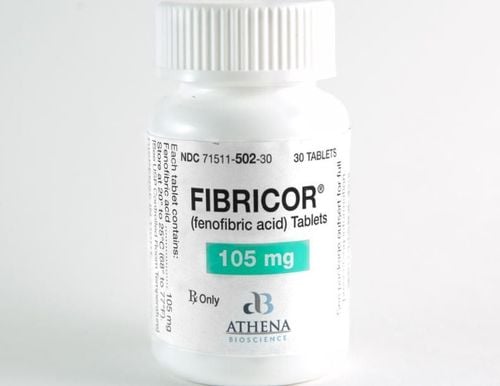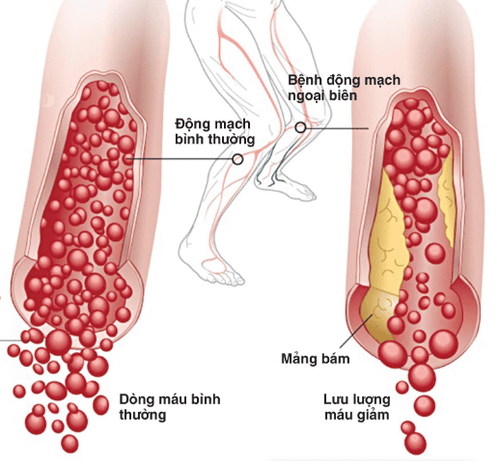This is an automatically translated article.
The article is professionally consulted with Master, Doctor Bui Tien Dat - Emergency Department - Vinmec Hai Phong International General Hospital.Chronic lower extremity artery disease (or chronic lower extremity ischemia) is caused by a variety of causes, often with a slow progression throughout life. So what is chronic lower extremity artery disease? Who is at high risk for the disease?
1. What is chronic lower extremity artery disease?
Chronic lower limb ischemia is a condition in which the aorta and lower extremity arteries are narrowed, obstructing blood circulation to the muscles and other related organs such as nerves, skin, etc. downstream. . This leads to anaerobic metabolism and increased production of lactic acid, which causes pain on exertion.However, later on, the patient can also feel pain in the lower extremities even when resting, accompanied by signs of ischemia such as skin ulcers, gangrene...
2. Classification of chronic lower extremity arterial disease
Currently, based on clinical symptoms, chronic lower extremity artery disease can be divided into 4 stages.Stage I: There are signs of loss of pulse of one or several vessels in the lower extremities, but there are no obvious signs of function. Stage II: claudication on exertion. This stage can progress differently: pain occurs when walking more than 150m or pain occurs when walking less than 150m. Stage III: pain occurs even at rest, especially when lying down, forcing the patient to sit with the legs open. Stage IV: There are some manifestations of nutritional disorders on the skin, the extremities begin to show signs of necrosis. Stage III and stage IV are often referred to as the "severe anemia" stage with very clear signs and symptoms:
Pain occurs continuously and often, even when lying down. Therefore, patients often have to use pain relievers. The foot is ulcerated and necrotic. Patients in the “severely ischemic” stage of chronic lower extremity artery disease have a poor prognosis. About 20% of patients require amputation and about 20% of cases die from the disease.
3. Subjects at high risk of chronic lower extremity artery disease
Based on epidemiological statistics, some of the following subjects are at high risk of chronic lower extremity artery disease:Under 50 years old, have diabetes or other risk factors such as high blood pressure pressure, smoking, hyperhomocysteinemia, dyslipidemia; People in the 50-69 age group, with a history of diabetes or smoking; People over 70 years old; People with symptoms in the lower extremities related to exertion, pain at rest; The patient has an abnormality in the arteries supplying the lower extremities; Patients with atherosclerotic arterial problems such as atherosclerosis in the coronary, renal or carotid arteries...

4. How is chronic lower extremity artery disease diagnosed?
Chronic lower extremity ischemia can be diagnosed based on:4.1 Clinical signs
Chronic lower extremity ischemia has 5 main clinical manifestations, including:No pain; Atypical leg pain; Pain in the lower extremities; Chronic severe anemia of the lower extremities; Acute lower extremity anemia.
4.2 Measurement of ankle-brachial index at rest (ABI)
Patients suspected of having chronic lower extremity artery disease through clinical symptoms will have their resting ABI index measured in order to detect the disease more accurately.This measurement is commonly used to diagnose lower extremity artery disease and needs to be measured in both legs to confirm the diagnosis.
Results of ABI measurement are as follows:
Arterial stiffness when ABI > 1.4 Normal if ABI is between 1 - 1.4 At risk of disease if ABI is between 0.91 - 0.99 Sick if ABI is less than 0.9
4.3 Doppler ultrasound of the arteries
The Doppler ultrasound gives significant value when diagnosing the lesion sites and supports the assessment of the degree of arterial stenosis.4.4 Magnetic resonance angiography (MRA)
Often used to evaluate arterial stenosis.4.5 Multi-slice tomography (CTA)
CTA will be considered in order to accurately diagnose the anatomical location of the lesion as well as determine the narrowing of the arteries for lower extremity artery disease.5. Guidelines for the treatment of chronic lower extremity artery disease
5.1 Controlling risk factors
Smoking cessation is a mandatory indication for patients with general vascular disease.Treat hypertension and diabetes if present, control blood sugar and blood pressure at a stable level.
Treat dyslipidemia if any.
To limit complications of skin ulcers and lesions on the legs, patients should: use socks, treat injuries early if they occur, limit exposure to cold environments and should not use drugs that cause contractions. circuit.

5.2 Medications
The drug groups used to treat chronic lower extremity anemia include:Antiplatelet drugs: Plavix, Aspirin... Anticoagulants belong to the heparin group. Drugs to improve arterial circulation, improve disease symptoms such as Praxilene, Torental, Pletaal...
5.3. Surgical treatment
Surgical removal of atherosclerotic plaque and the use of artificial vessels to widen the artery at the site of atherosclerosis; Arterial bypass surgery; Amputation of limbs in case of signs of limb necrosis. Chronic lower extremity artery disease is a persistent and progressive disease. Therefore, patients with signs need to be examined early to control factors that increase disease progression and minimize complications due to arterial occlusion.Vinmec International General Hospital is one of the prestigious medical facilities in Vietnam with a team of dedicated, experienced, highly qualified medical professionals. The system of modern and advanced equipment helps to diagnose the disease accurately and quickly.
Please dial HOTLINE for more information or register for an appointment HERE. Download MyVinmec app to make appointments faster and to manage your bookings easily.














